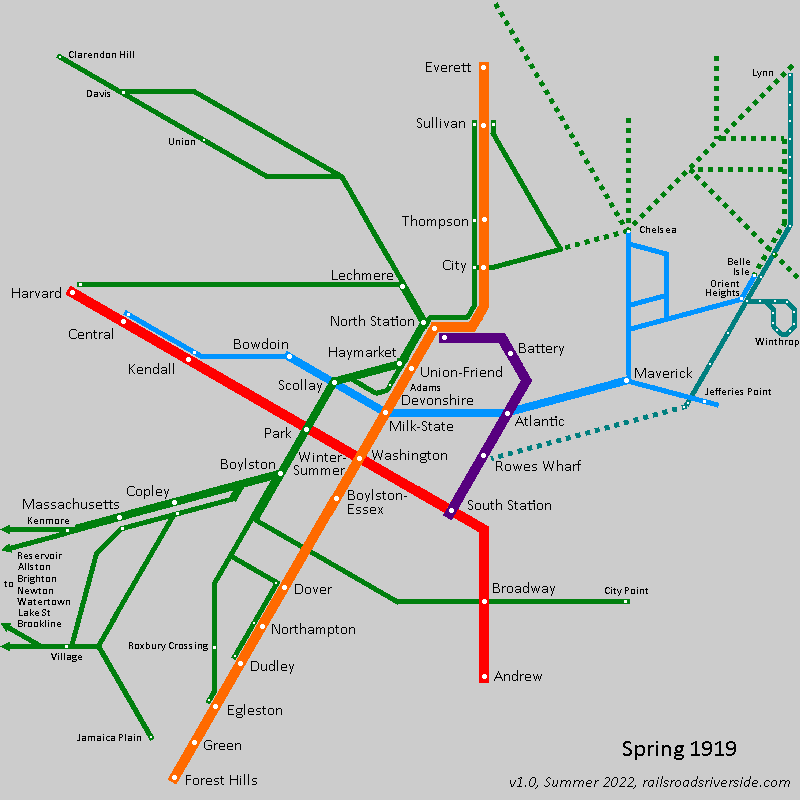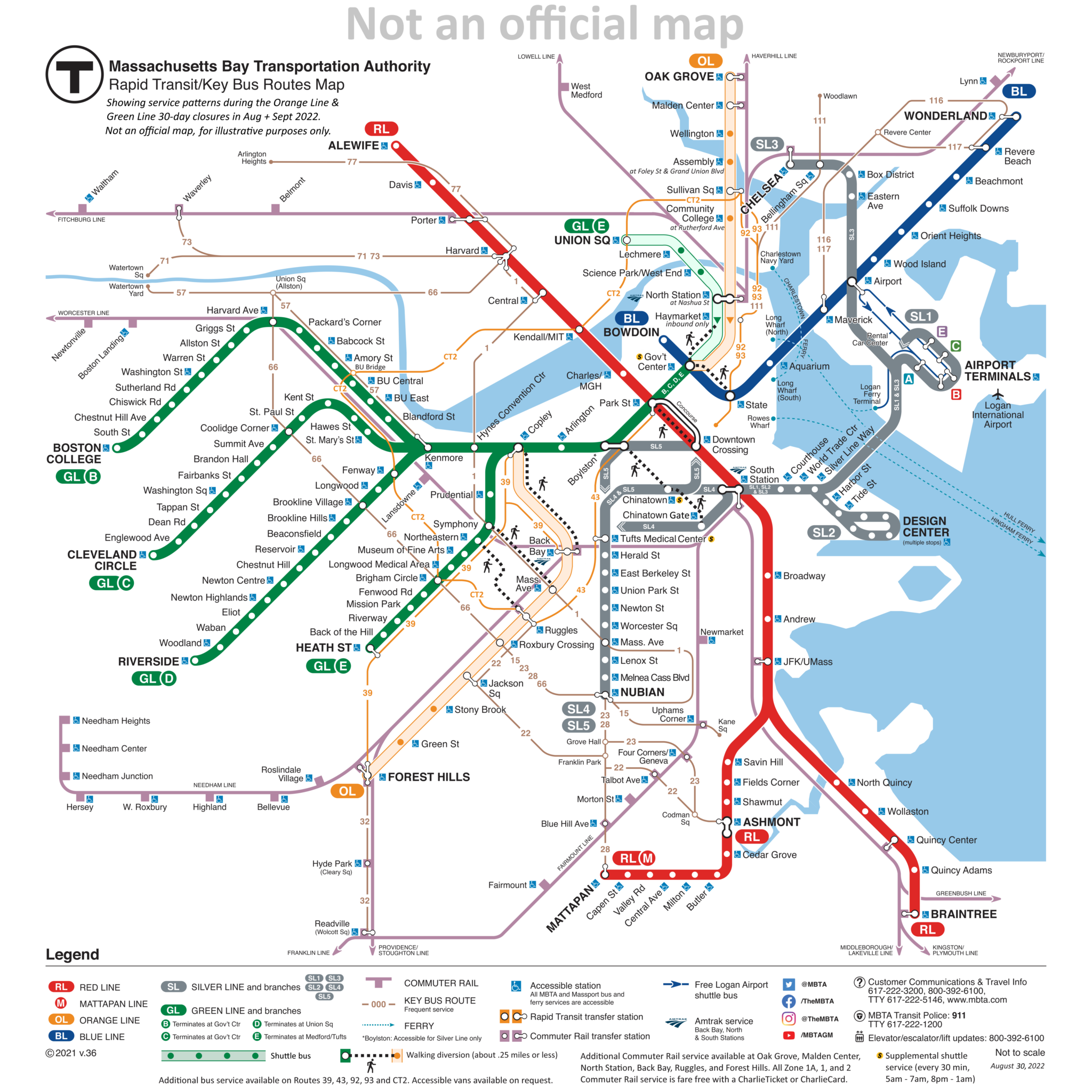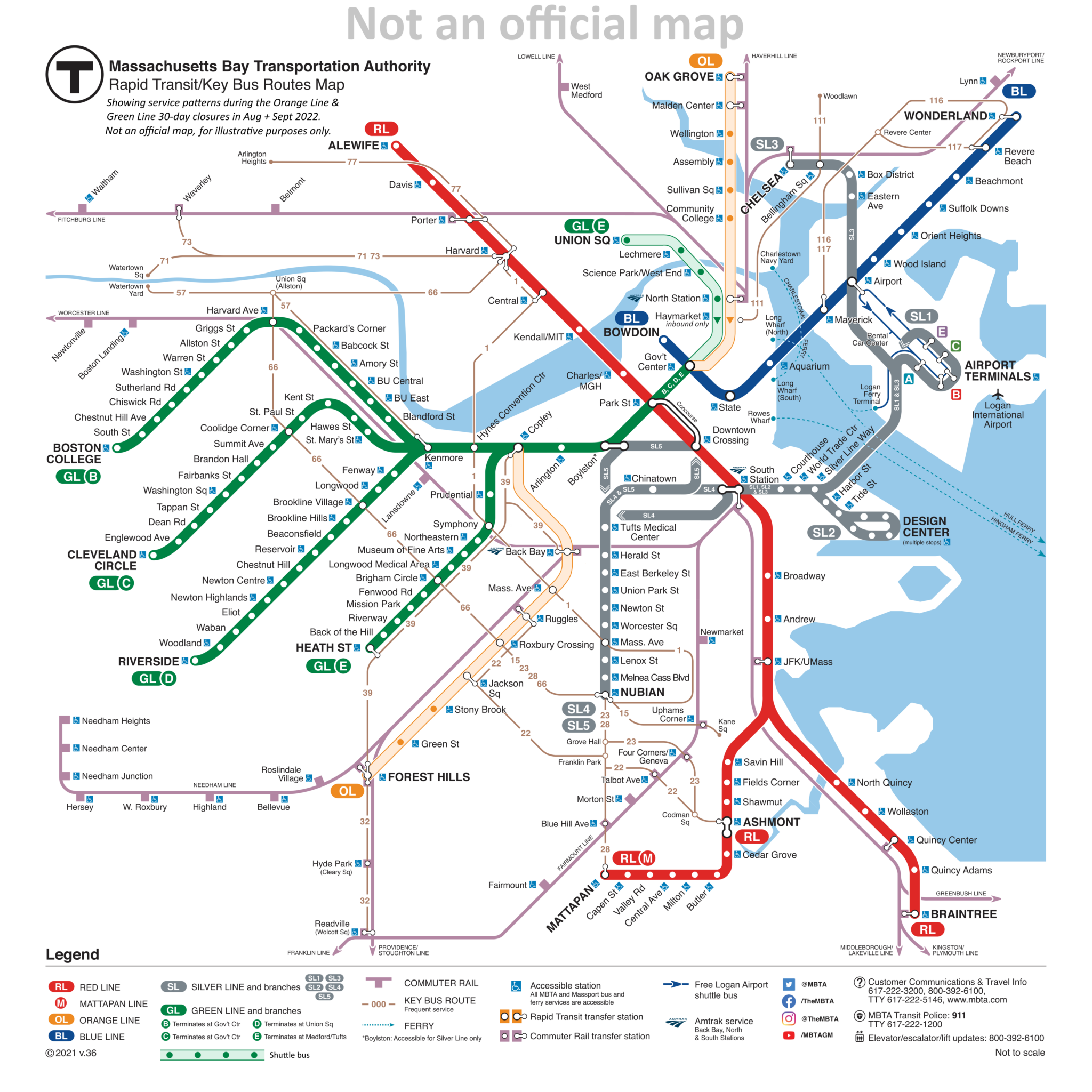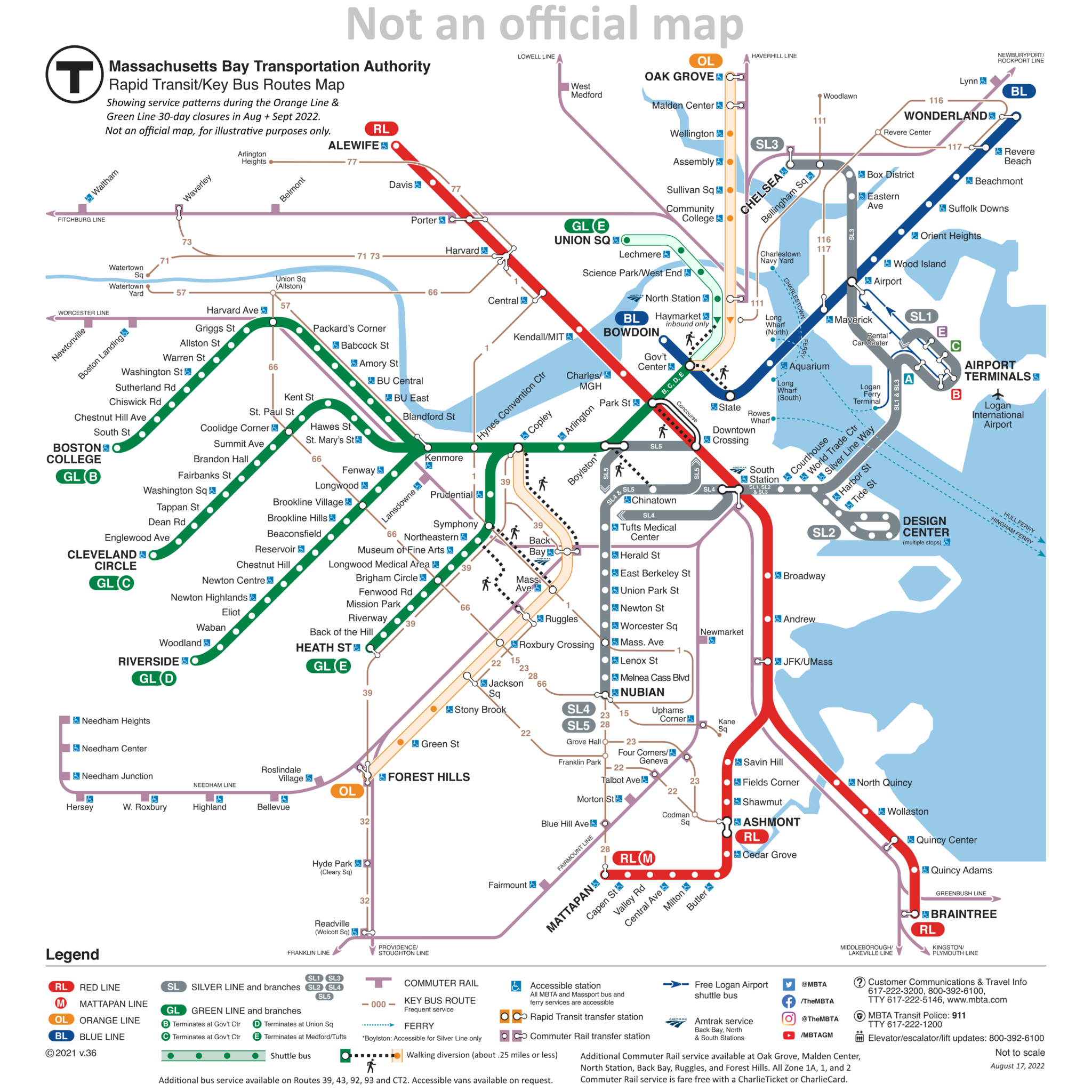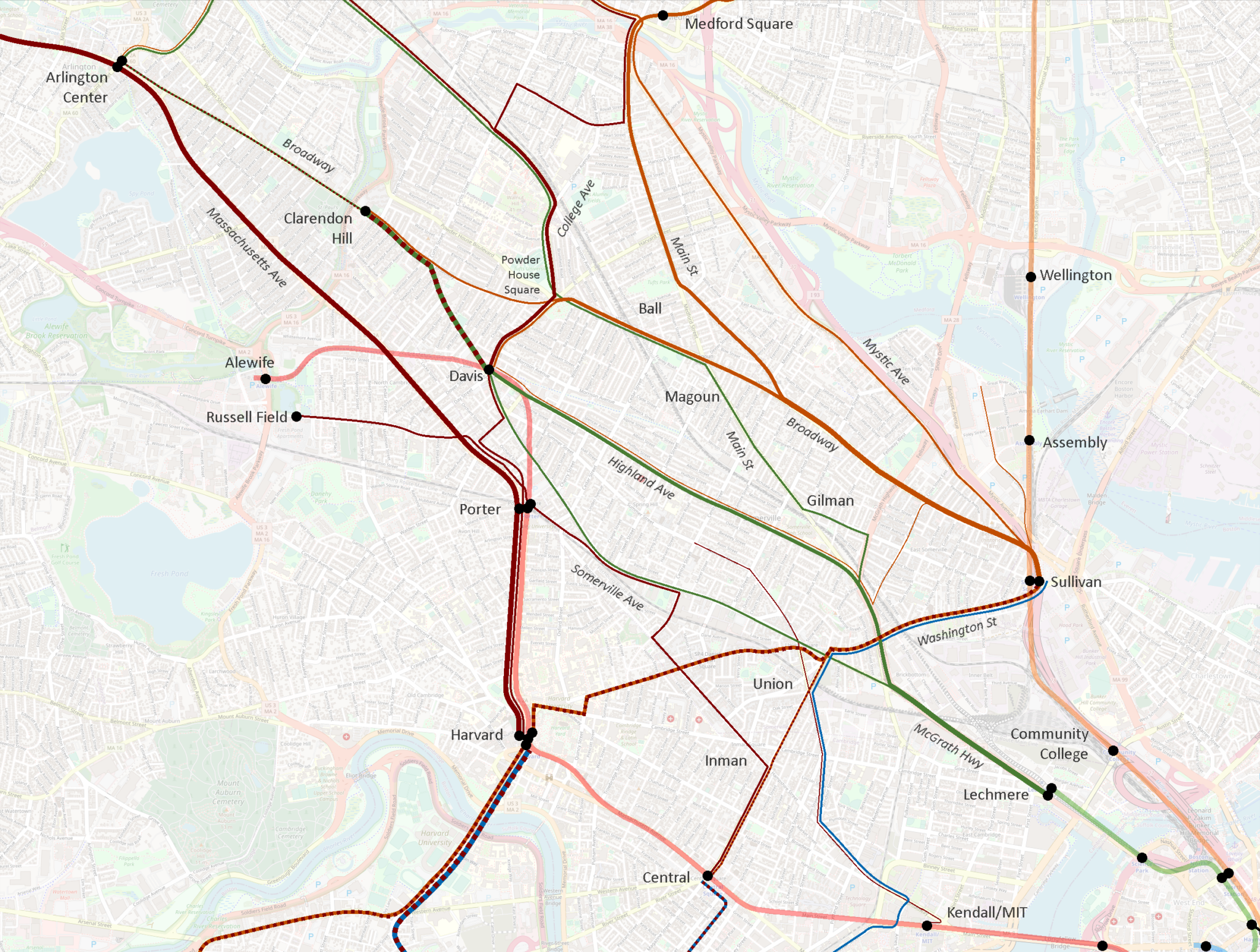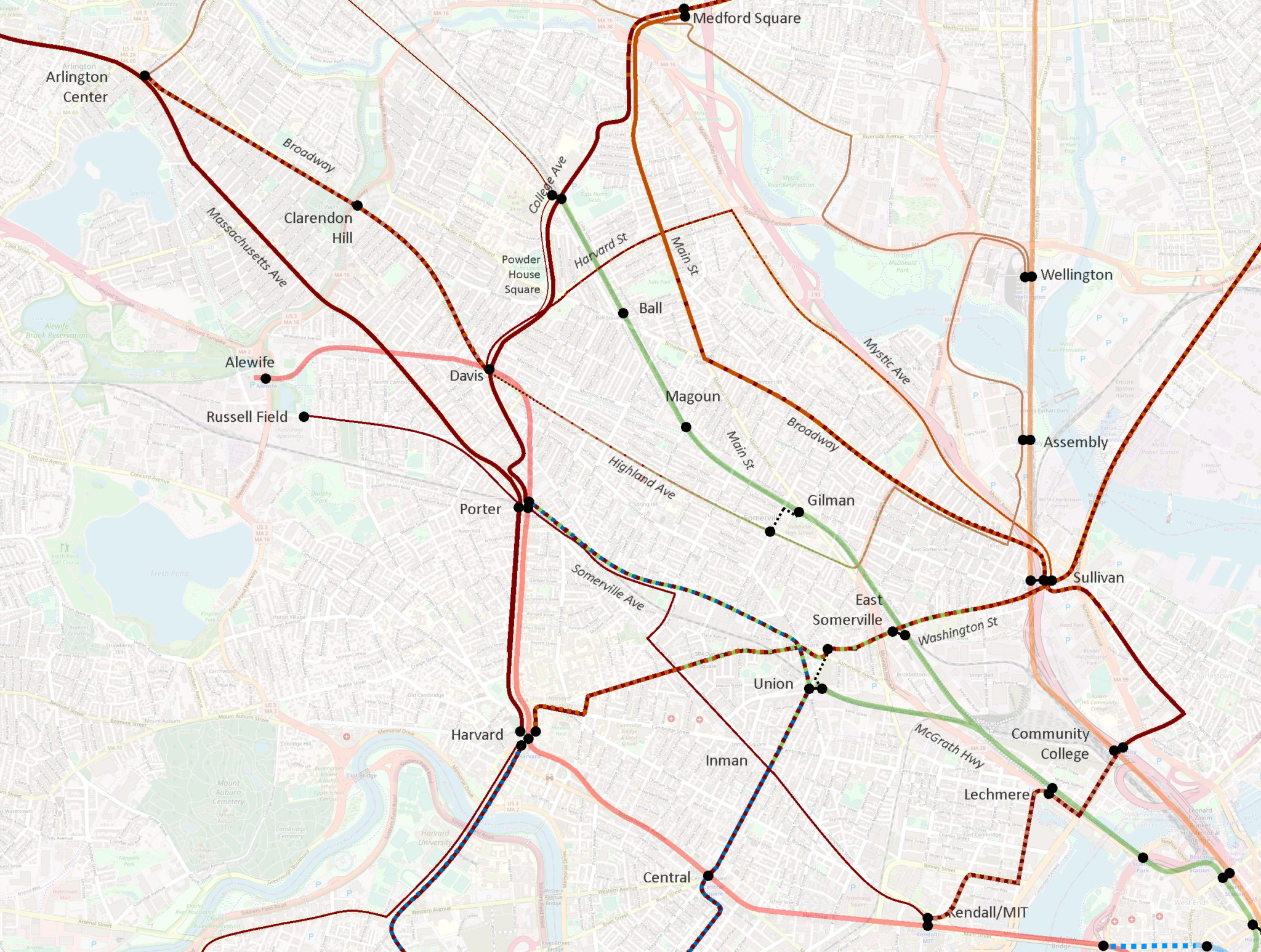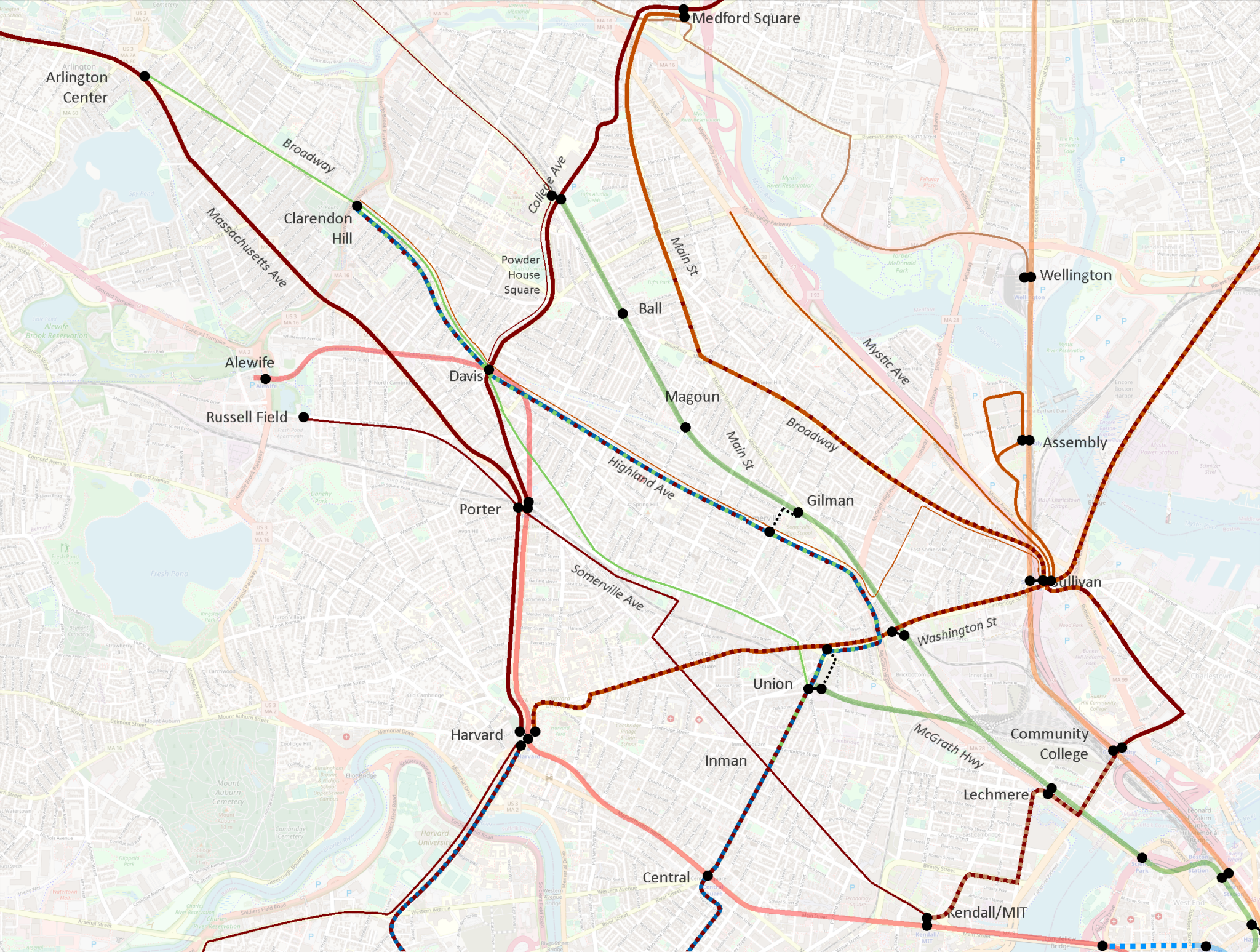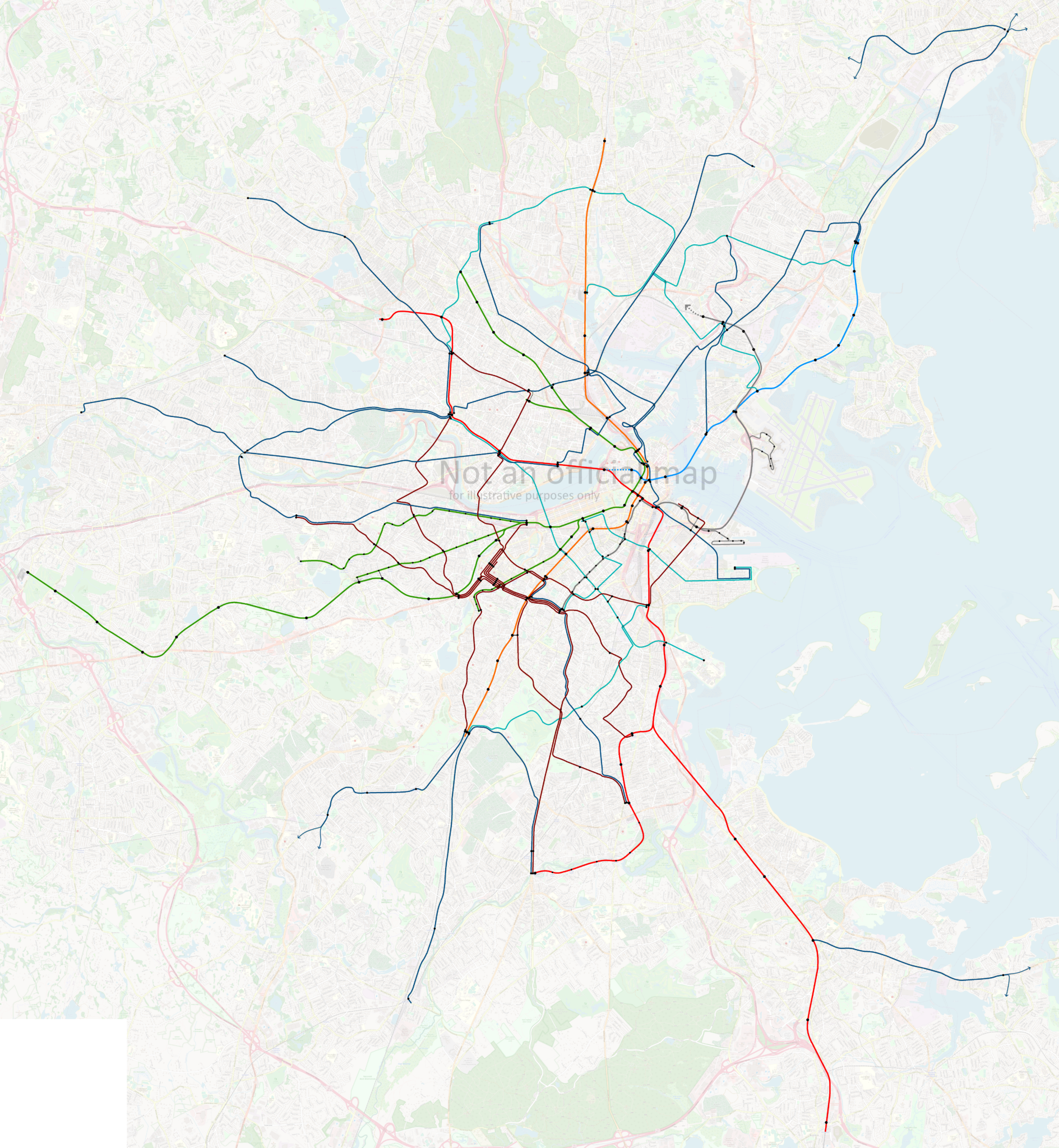Earlier this year, I described how Aldgate Junctions can be used to provide additional service along branchlines without impacting capacity on the core. But Aldgate Junctions have their limitations – a lesson that the Boston Elevated Railway (BERy) learned the hard way, 100 years ago.
The original Main Line El network
When what is now the Orange Line was first built, it was very different. In fact, the earliest iteration of the Orange Line did not use a single piece of track, tunnel, station, or right-of-way that the current Orange Line uses.
The Main Line El, as it was called, was opened in 1901, as a collection of three elevateds and one subway: the Charlestown El, the Washington St El, the Atlantic Ave El, and the Tremont St Subway. Yes – despite being opened less than 5 years before as a streetcar subway, the Tremont St Subway was semi-temporarily converted to third-rail and high-level platforms. (The four-track sections of the subway saw the inner tracks maintained for streetcars.)
The infrastructure of the Main Line El when it opened looked something like this:
Single els at the northern and southern ends were connected by a pair of downtown trunk lines, all linked together by a pair of Aldgate Junctions, the northern junction called “Tower C”, and the southern one called “Tower D”. This arrangement allowed all trains to run everywhere. For example, the following array of service patterns would have been readily achievable, with bidirectional service on each “line”:
(Note that I’m not sure a full service pattern like this ever existed; but, as you will see below, it looks like BERy experimented with many permutations, so this one may have been attempted at one point or another.)
Shifting into the Washington Street Tunnel and reshaping the network
The original network was short-lived. Within the decade, the Washington Street Tunnel opened:
As you can see, the Aldgate Junction at Tower C was preserved, but Tower D was modified into a simple flat junction. I argue that the asymmetric presence of the northern Aldgate Junction fatally undercut the Atlantic Ave El’s ability to contribute usefully to the network.
Mapping the lasting impact of the asymmetric Aldgate Junction
In the course of researching another project, I ended up doing a deep dive into BERy’s experiments with different service patterns on the Atlantic Ave El from 1919 to 1924. You can follow the evolution step-by-step below.
Ultimately, I would argue that the problem they were trying to tackle was a geometric one. Without an Aldgate Junction at Tower D, the Washington St El is hobbled by reverse-branching: every train you try to send from Dudley to Atlantic is one fewer train that you can send from Dudley to downtown; as it is today, downtown was the more popular destination and could hardly afford to lose service.
Trying out a shuttle service + deinterlining
This is why it is unsurprising that in 1919, BERy stopped running trains from Dudley to Atlantic via Beach St – all trains from Dudley would run through the Washington St Subway, as detailed in this newspaper announcement:
As you can see, BERy sought to increase frequencies on both the Tunnel and the El by isolating each other’s services; the Tunnel would be served by Forest Hills/Dudley-Sullivan trains, and the El would be served by North Station-South Station shuttles. (Not mentioned here is a dedicated track that existed at North Station, allowing Atlantic shuttles to reverse direction without blocking Tunnel traffic.) Drawing on the style of the Cambridge Seven Associates “spider map”, a diagram of the system at the time might have looked like this:
This was certainly a reasonable idea, and is a technique called “deinterlining” that remains in use to this day. (Every so often, you will see someone put forward a proposal to deinterline the NYC Subway, for example.) Two low-freq services offering dedicated one-seat-rides to multiple destinations are reshuffled into two high-freq services that provide higher frequencies to all stations, improve reliability, and maintain some OSRs, at the cost of turning other journeys into two-seaters.
The push for deinterlining highlights a common pitfall of Aldgate Junctions: it entangles all three branches into a single shared timetable. Trains on one branch need to be coordinated with trains on both other branches. Even if your train is bypassing a branch, delays on that branch will still impact your journey through ripple effects.
Pitfalls of a deinterlined main line + shuttle, and an attempt at remediation
But BERy’s own announcement reveals a fatal flaw in their plan: most of the major destinations on the Atlantic Ave El could be reached by other two-seat rides that were often more direct, especially for riders coming from the south. Why would anyone board a train at Dudley, ride it all the way to North Station, and then transfer to a shuttle and ride it the long way round to disembark at Atlantic (today’s Aquarium)? It would likely be significantly faster to transfer at State/Milk/Devonshire and ride an East Boston train one stop. (And probably would be just as fast to walk.)
And from a convenience perspective: a two-seater is a two-seater, so Washington + East Boston is equally convenient as Washington + Atlantic. At that point, journey time becomes the deciding factor.
Perhaps an Atlantic shuttle service could have been more successful if it had offered a southern transfer at Dover. Unfortunately, the Washington St El’s station construction style meant that significant capital investments would have been required to turn trains at Dover.
As it stood, the 1919 Atlantic shuttle service was useful for three specific things:
- Shuttling passengers between South Station and North Station
- Perhaps of limited use to long-distance travelers, but hardly a large market
- Serving Battery St
- Located at the farthest edge of the North End, with half of its walkshed underwater
- Serving Rowes Wharf
- Faced with declining ferry ridership and likewise only half of a walkshed
That is pretty wobbly, especially given the cost of maintaining the El and the diversion of rolling stock away from more heavily used segments.
(Of note – though I believe ultimately not of very much consequence to this particular topic – is the Great Molasses Flood, a disaster that occurred about two weeks after BERy’s announcement, and which put the Atlantic Ave El out of service for over two months.)
This experiment in pure deinterlining was short-lived. Just six months later (and less than three months into the service actually being consistently run following the flood), a Dudley-Atlantic-Sullivan service was reinstated:
Which would have looked like this (although I am unclear whether the Sullivan-Dudley service itself was weekends-only):
Implementing a “wraparound” service
The Dudley-South Station-Sullivan service – whether it was truly daily or only on weekends – only lasted another six months. In December of 1919, a fascinating “wraparound” service was instituted that essentially turned the Atlantic Ave El into a second northern branch of this predecessor to the Orange Line:
This change was briefly announced in November:
But it was given much more fanfare upon actually starting in December, including an interview with the Superintendent of Transportation. The article also includes details on the frequencies breakdown:
The core stretch through the Washington Street Tunnel would see 24 trains per hour (tph) at peak. To the north, 8 of those trains would head to South Station, while the other 16 would go to Sullivan; in essence, BERy “paid” for a one-seat-ride to the Atlantic Ave El by diverting about one-third of Sullivan trains.
(To the south, it should be noted, the 8 tph from South Station were short-turned at Dudley, again leaving the other 16 tph available to serve Forest Hills, though I’m not sure that they all did.)
Seasonal direct service
Sometime in the summer of 1920, a direct Dudley-South Station-Sullivan service was reinstated, to accommodate increased traffic from summer travelers. It’s unclear to me whether a North Station-South Station service remained during this time.
Wraparound service + shuttle
However, by the end of September, the through-run was canceled, replaced by a return of the wraparound service – now only 6 tph – but now supplemented by a dedicated North Station-South Station shuttle, also running at 6 tph.
Again, we see BERy reducing the frequency of one-seat rides, but adding additional short-turn service to raise frequencies on the El itself higher.
Low-freq seasonal direct service + high-freq shuttle
Once more, however, after several months BERy shifted the service pattern again. In June 1921, BERy announced the return of Dudley-South Station-Sullivan direct service, citing the need to accommodate summer travelers.
Once again, the wraparound service was discontinued. This time around, however, BERy reduced the frequency of the direct service lower than I believe they ever had before: only 5 trains per hour. This was again supplemented by a much higher frequency on the North Station-South Station shuttle, which saw 10 tph during rush hour.
I think there’s actually a lot to be said for this arrangement. The lack of wraparound services means that trains aren’t doubling back on themselves; the frequency for Dudley-Atlantic-Sullivan services seems to match the present-but-low demand, sitting at the edge (but still within) the realm of “turn up and go”; and frequencies remain high on the core segments, meaning that riders who are impatient have the alternative of a two-seat journey between services with high frequencies (and therefore short transfer times).
Reverse branching from the south
It’s unclear to me whether BERy returned to a “Winter” service pattern after the 1921 Summer was over, and if so, which Winter service pattern they used.
However, it appears that the Summer pattern was again used in Summer 1922, before being replaced in September 1922 with yet another new service pattern:
This pattern essentially extended the North Station-South Station shuttle – a relatively constant fixture of all these variations – from South Station to Dudley. This again turned the Atlantic Ave El into a second northern branch of the Main Line El, but shifted the split point to the south to avoid the roundabout journeys of the wraparound pattern. This of course came at the classic cost of reverse branching: radial service from Dudley was rerouted away from the core, reducing the number of trains that could run between Dudley and Downtown.
As I understand it, this service pattern remained somewhat stable, though I am unsure how long it remained in place. By 1924, the predecessors to the Blue and Green Lines saw many of their surface routes truncated at Maverick and Lechmere respectively, which leaves us a map like this:
Writing on the wall
In 1926, the Report on improved transportation facilities in the Boston Metropolitan District noted that (p. 26):
At the present time the Atlantic Avenue Elevated loop is utilized principally as a rapid transit connection between the North and South Stations. It also affords a convenient means of reaching the several steamboat and ferry terminals along the waterfront. The total traffic served by this loop is not particularly important in a comparative sense.
That same report called for the demolition of the Atlantic Ave El and replacing it with an “elevated roadway” (p. 41 and on) – essentially proposing the Central Artery, some 30 years before its time.
By the late ‘30s, BERy listed the Atlantic Ave El as a separate route on its maps, running primarily between North and South Station. The El itself was demolished in 1938.
Other disadvantages faced by the Atlantic Ave El
To be clear, there were a number of factors that put the Atlantic Ave El at a disadvantage. For one, running along the shoreline meant that half of its walkshed was literally underwater. The route also avoided the densest parts of downtown Boston, in favor of serving the docks, which also reduced transfer opportunities to the Tremont Street streetcar services and to mainline railroads at North Station.
(Transfer opportunities to the East Boston Tunnel were available at Atlantic, and to the Cambridge-Dorchester Subway at South Station; I would speculate, however, that passengers would likely prefer the shorter and fully-indoors transfers available on the Washington St Tunnel.)
Serving the docks was an understandable design decision at the time, but became more problematic as time went on. Tunnels under the harbor significantly reduced ferry ridership; for reference, the highly popular Boston, Revere Beach & Lynn Railroad ferried passengers across the harbor from their terminal at Jefferies Point to Rowes Wharf – surely a large source of passengers for the El.
Finally, it bears mentioning that Elevateds themselves quickly became unpopular. They were noisy, unsightly, and brought the noise of transportation up from street-level directly outside residents’ windows. Furthermore, since the Els were a rapid transit service that BERy used to express riders in from streetcar transfer hubs further out from downtown, stops were spaced distantly, and thus provided that much less advantage to residents who endured the costs of living nearby.
What if?
Would things have been different if Tower D had been maintained as an Aldgate Junction? It’s hard to say. Maintaining a central “loop” service as I showed in my diagram above would still mean reducing the number of trains that could run directly between Dudley and downtown.
On the other hand, a loop would have kept frequencies maximally high within the core Washington Street Tunnel, keeping capacity high for transfers from Cambridge, Dorchester, East Boston, and North Station. A loop service would also have created a one-seat ride from South Station to (what is now) Chinatown, State, and Haymarket.
Would it have been enough to save the Atlantic Ave El? In the end, I doubt it. The waterfront routing and probably the mere fact of being an elevated likely would have doomed it anyway. These were the early days of rapid transit – some ideas were simply best guesses, and so some ideas were inevitably wrong.
Lessons for today
It’s clear that the asymmetric availability of an Aldgate Junction following the construction of the Washington Street Tunnel is the fundamental reason BERy kept changing the service patterns seemingly every six months circa 1920. BERy was trying, I would argue, to solve a physically impossible puzzle, experimenting with basically every possible permutation of service on the El, and failing to make any of them work.
The history of the Main Line El offers a lesson, not in the benefits of Aldgate Junctions, but in the perils of reverse branching and doubleback services. A key advantage of an Aldgate Junction is the “branch bypass” service: recall BART’s Orange Line that runs from Richmond to the East Bay without entering the core in San Francisco.
In the case of the Atlantic Ave El, that advantage was negated: the experimental wraparound service was inefficient because it was a doubleback service that was roundabout and not fast enough to compete with more direct two-seat journeys. South Station-Sullivan service avoided the core of downtown, and consumed slots needed for the more valuable Sullivan-Dudley service.
Why does it work in London?
London’s example may be a closer comparison than the BART’s: the eastern end of the Circle Line is also a doubleback service, as can be seen in the 2015 London Connections Map:
Why does it work in London where something similar failed in Boston? I think there are a few reasons:
- London has more people – a lot more people. Greater London had about 7.5 million residents in 1920, while Boston had a tenth of that (see pg. 143). Being physically smaller, 1920s Boston may actually have been roughly as dense as London, but you could probably fit (and I’m making a wild guess here) four or five “Bostons” into London’s areas of high density.
With that many people, the numbers game really begins to change. (This is a useful point to remember when comparing [Western] cities to London, New York, and to a certain extent Paris and Los Angeles – those cities are simply different due to their scale and are hard to use for comparisons.)
- The northern and southern legs of the Circle Line are a little bit further apart than the El and the Tunnel were, increasing incentive for passengers to ride around the bend even if it is slightly more roundabout.
- The Circle Line has fewer “crossing services” than Boston did: recall that riders could use the predecessors to the Red and Blue Lines to access most of the stops served by the El; London by contrast had more stops and fewer crossing services.
If you were coming from Farringdon or points west and wanted to go to Monument, you could alight from the Circle Line at Moorgate and transfer to the Northern Line and go south one stop… but if you were going to Cannon Street or Mansion House, then you’d need to get back on a Circle or District Line train anyway, so why not stay on? The Central Line and Thameslink also presented options, but might have been undesirable for other reasons (see below).
- London’s large population becomes relevant when considering transfers; I don’t know what it was like in 1920, but today those segments of the Northern Line and Central Line are extremely crowded, while the Circle Line is noticeably less so. This again incentivizes riders to continue “round the bend”, to avoid an extremely crowded transfer.
Planning and crayoning
So what does all this mean from a transit planning and crayon mapmaking perspective? It means that an Aldgate Junction can solve some problems with branching, but it’s not a cure-all.
It’s still vulnerable to the pitfalls of reverse-branching, diverting radial services away from the core. Every train from Dudley that went to South Station was a train taken away from the more valuable Dudley-Downtown route.
If the branches are close together, then an Aldgate Junction becomes less useful because it won’t be used for through-journeys from branch to branch – there will be other “crossing services” (including walking or biking) that are faster. Someone journeying from Scollay Square to what is now Aquarium was better off traveling via the East Boston Tunnel than going the long way around.
If the branches are long and are corridors unto themselves, then the Aldgate Junction can still be a useful way to increase frequencies within the corridor – but in that case it may be more efficient and reliable simply to short-turn supplementary services within the branchline itself, rather than deal with the logistics of a junction.
In a Boston context, this would be relevant on the western branches of the Green Line: a “wraparound service” that jumps from the B to C Lines while avoiding Kenmore would be a poor alternative to the (idealized, well-running) 66, 65, or 47 buses. If frequencies need to increase within the Beacon or Commonwealth corridors, short-turning trains at Blandford St, St. Mary St or Kenmore would be more reliable and less complex than a junction.
(This also holds true, in my opinion, at the western end of those branches, where there is a true set of Aldgate Junctions at Cleveland Circle and Chestnut Hill Ave.)
Summary
An Aldgate Junction is more useful when as many of the following are true:
- Branches are evenly distributed geographically
- The region is pluricentric, where key destinations are located across multiple branches
- The branches are long and form corridors unto themselves
- Direct “crossing services” (such as circumferential routes) are not available between the branches, or are too centralized resulting in three-seat-journeys (such as Farringdon-Moorgate-Monument-Cannon Street)
Even before the elimination of the Aldgate Junction at Tower D, the Atlantic Avenue El failed all of these. Following the relocation into the Washington Street Tunnel, BERy was hamstrung with no way to serve the El without incurring reverse-branching, doubleback services, or both. This is vividly illustrated by the rapid changes and experimentation with service patterns circa 1920.
While the Atlantic Avenue El was demolished over sixty years ago, its history can still teach us lessons today.
Addendum: a GIF
